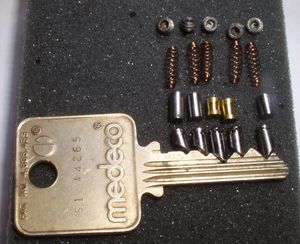smithers43 wrote:thanks a bunch man much appreciated! when you were talking about certain pins being the setting pins or something, does that mean that you have to get that one first and THEN the others will set at the sheer line? also i believe my lock has 3 pins? but maybe it has four, regardless looked at the masterlock thread and what exactly are security pins?
sorry for all the dumb questions but it seems like a fun hobby
While talking about setting pins, I (and about everybody else I think) means those pins which "bind" when putting some torque to the cylinder due to machining tolerances in the lock which don't make their alignment perfect. By using this "defect" in the lock, you can feel which driver pin is ready to "fall" in its proper position just beyond the sheer line, by manipulating the key pin.
Manipulating the key pins one by one in order to set the driver pins properly (as the key was intended to do) unlocks the cylinder.
I think that your lock has 4 pins, so unless Master Lock made a different model, I think there is one you can't yet feel with your pick.
As fredy pick already suggested, have a look at your key. In case that wikipedia picture was too theoretical, I dug up a real life picture of a key and pins. This should give you an idea of how you can count the pins in your lock by looking at its key. Those dents on the key are where key pins make contact and reach the correct level to unlock the lock.

Image by user Datagram. Uploaded on Lockwiki. URL
http://www.lockwiki.com/index.php/File: ... o_pins.jpgThat is a Medeco lock though, your Master Lock key pins are probably more rounded.
Security pins are an added measure to prevent easy (I know at the beginning even picking regular pins isn't that easy!) picking of the lock. They come in various shapes, the most common ones are spool, mushroom and serrated and are usually present as driver pins though some locks also have modified key pins.
When you're manipulating a key pin which has a spool pin above, by applying light torque and pushing it up, you'll see the cylinder rotate some degrees and getting stuck there. That's because the spool pin was pushed only partially and it's getting stuck diagonally in the shear line, preventing further rotation (and of course opening of the lock). If you'll relieve torque on the lock and carefully push the same key pin some more, you'll be able to make that spool pin pass the shear line and set properly. Of course you have to master regular pins and good feeling in order to achieve success at locks with security features.
Here is an article about security pins on lockwiki
http://www.lockwiki.com/index.php/Security_pin and a short spool pin animation on youtube
http://www.youtube.com/watch?v=enFRn189Qo0There is quite some literature about them in the forums and elsewhere in the net, I suggest practicing with locks without security pins first as they're easier.
If you feel stressed by not being able to open that lock, I suggest try raking with a half diamond pick (which you surely have in your set, being one of the most common designs) as an ego booster. It's that one which looks like it has a "triangle" at the tip. Put a little tension on your lock and rake with your half diamond back and forth at the pins. They'll begin to set and you should be able to open it.
Again this is a less orthodox technique which I suggest not to get frustrated on that particular lock. In some cases raking also saves time compared to pin to pin picking, but the latter is
very important because it builds feeling to tackle harder to pick locks.
Enjoy

